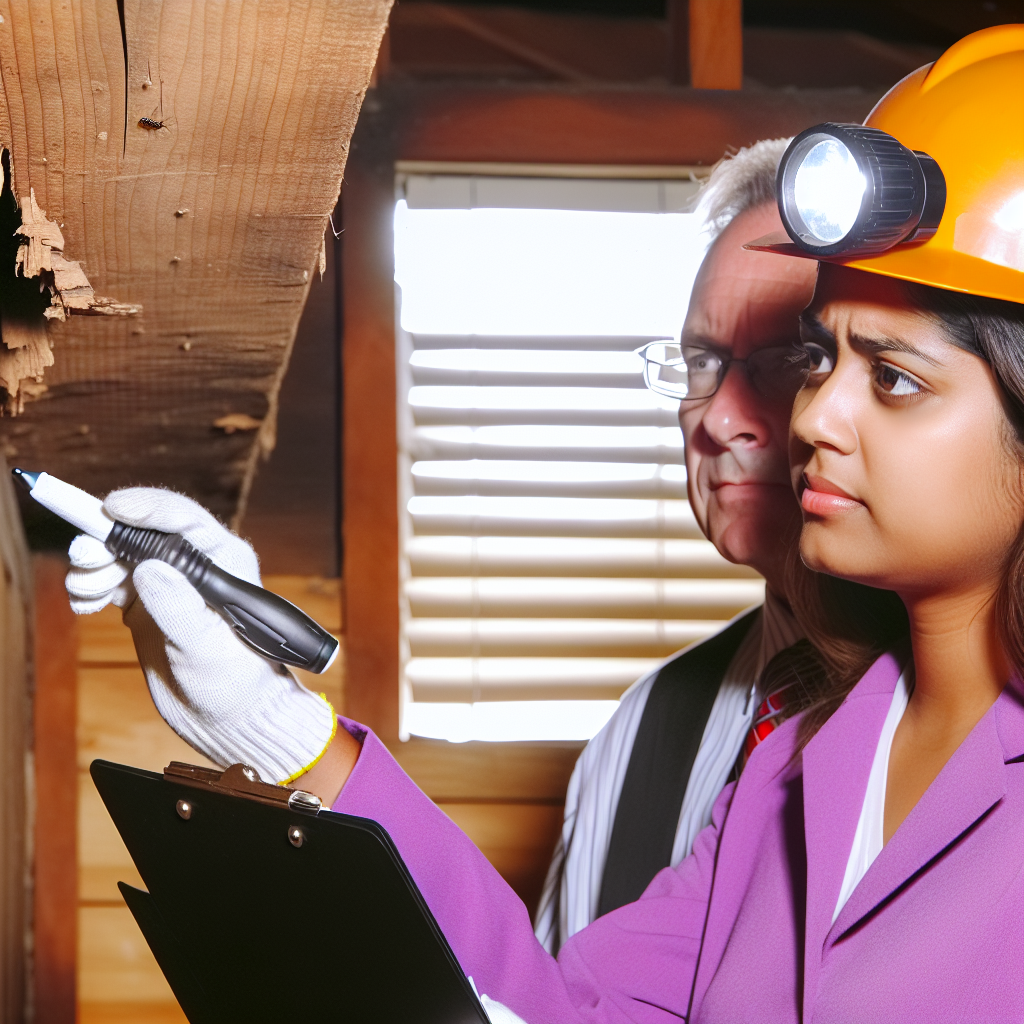Understanding Termites: Types and Behavior
Types of Termites
Termites fall into three main categories: drywood, subterranean, and dampwood.
Each type has distinct habitats and behaviors.
Drywood termites live in wood and do not require contact with the soil.
Subterranean termites, on the other hand, live underground and build mud tubes.
Dampwood termites thrive in decaying wood with high moisture content.
Behavior of Termites
Understanding termite behavior helps in identifying infestations.
Termites consume cellulose found in wood, paper, and plant materials.
They often work in colonies, which can range from a few hundred to millions.
This cooperative behavior allows them to efficiently locate and process food sources.
Winged termites, also known as swarmers, leave their colonies to reproduce.
They typically swarm in warm weather during spring, signaling potential new infestations.
Signs of Infestation
It’s crucial to recognize early signs of termite infestations.
Look for mud tubes on walls; they indicate subterranean termite activity.
Additionally, hollow-sounding wood may reveal damaged areas.
Another telltale sign is discarded wings from swarming termites.
Transform Your Real Estate Decisions
Unlock personalized real estate insights crafted just for you. Get actionable advice designed to amplify your success.
Get StartedLastly, frass, or termite droppings, can also signify an active colony.
Identifying Signs of Termite Damage in Homes
Visible Wood Damage
Inspect the wooden structures in your home.
Look for hollowness in beams, floorboards, and furniture.
Termites eat wood from the inside out.
This often leaves a thin outer layer intact.
Additionally, check for any peeling or blistering paint.
Frass and Droppings
Termite droppings, known as frass, resemble tiny pellets.
Look for these.
Essential Tools for Conducting a Home Inspection
Inspection Checklist
A thorough inspection checklist is crucial for identifying termite damage.
This checklist helps ensure no areas are overlooked during inspections.
Flashlight
A sturdy flashlight allows for a detailed examination of dark areas.
Termites often hide in shadows, making good lighting essential.
Consider using a flashlight with a focused beam for precision.
Moisture Meter
A moisture meter detects hidden moisture that attracts termites.
Showcase Your Real Estate Business
Publish your company profile on our blog for just $200. Gain instant exposure and connect with a dedicated audience of real estate professionals and enthusiasts.
Publish Your ProfileTermites thrive in damp environments, making this tool invaluable.
By measuring moisture levels, you can pinpoint potential infestations.
Screwdriver
A screwdriver helps access potential areas of termite damage.
Use it to pry open wooden surfaces and inspect for soft spots.
This tool aids in examining both structural integrity and infestations.
Camera
A camera is useful for documenting any findings during the inspection.
Taking pictures allows you to keep a record of problem areas.
This documentation is helpful for future reference or professional evaluations.
Protective Gear
Always wear protective gear during inspections for personal safety.
This includes gloves, goggles, and masks to prevent exposure.
Termite-infested areas can expose you to harmful substances.
Wood Borer Inspection Tool
A wood borer inspection tool allows for a closer examination of damaged wood.
This specialized tool detects signs of burrowing and infestation.
Using it can uncover hidden termite activity beyond the surface.
See Related Content: How to Spot Red Flags During a Home Inspection
Inspecting the Exterior: Areas to Focus On
Foundation and Skirting
Begin your inspection at the foundation of the house.
Look for any cracks or holes that may allow termites to enter.
Check the skirting boards for damage or signs of pest activity.
Additionally, inspect any wood-to-soil contact points.
Walls and Siding
Examine the exterior walls and siding for signs of termite damage.
Look for small holes that indicate entry points for termites.
Also, pay attention to any bubbling or blistering paint.
This can signal moisture accumulation and potential termite activity.
Windows and Doors
Inspect the frames of windows and doors closely.
Check for any signs of wear or soft wood that may suggest infestation.
Termites often damage these areas, so they require thorough evaluation.
If the wood feels spongy, it may be a cause for concern.
Landscaping and Surroundings
Examine the landscaping around the house.
Ensure no wooden structures, like fences or decks, touch the soil.
Termites thrive in environments with excessive moisture and wood debris.
Showcase Your Real Estate Business
Publish your company profile on our blog for just $200. Gain instant exposure and connect with a dedicated audience of real estate professionals and enthusiasts.
Publish Your ProfileAdditionally, remove any mulch or wood chips near the foundation.
Basement and Crawl Space
Never overlook the basement or crawl space during your inspection.
Check for any signs of water damage or moisture buildup.
Inspect wooden beams and supports for any visible damage.
If you find discarded wings or frass, it’s time to act.
Signs of Active Infestation
Look for the presence of mud tubes on exterior walls.
These tubes indicate that termites are actively foraging for food.
Additionally, inspect for the presence of termite droppings.
Frass resembles small wood-colored pellets and confirms infestation.
Uncover the Details: The Benefits of Pre-Approval Before Starting Your Home Search
Inspecting the Interior: Key Areas to Check
Look for Visible Signs of Damage
Examine wooden structures for signs of tunneling.
Check for hollow-sounding wood, indicating internal damage.
Inspect baseboards and door frames closely.
Look for mud tubes on walls or foundations.
Pay attention to any frass, which resembles sawdust.
Check the Attic and Basement
Inspect the attic for damaged rafters or beams.
Check for moisture, which attracts termites.
Examine the basement for signs of structural weakening.
Additionally, look for signs of water leaks that may encourage infestations.
Examine Windows and Doors
Check window frames for soft or damaged wood.
Inspect door frames for similar signs of deterioration.
Ensure that weather stripping is intact to prevent access.
Look for gaps around the frames where termites can enter.
Walls and Ceilings
Inspect walls for stains or discoloration from moisture.
Look for peeling paint or wallpaper bubbles, which may indicate moisture.
Check ceilings for cracks or sagging, as they can suggest structural issues.
Flooring and Carpeting
Inspect wooden flooring for warping or soft spots.
Check carpets for dampness or unusual odors indicating mold.
Ensure all floorboards are firmly attached and inspect underneath.
Get Professional Help if Needed
Consider hiring a pest control expert for a thorough inspection.
Showcase Your Real Estate Business
Publish your company profile on our blog for just $200. Gain instant exposure and connect with a dedicated audience of real estate professionals and enthusiasts.
Publish Your ProfileRegular assessments can save you from extensive damage.
Early detection helps in taking preventive measures.
Discover More: Why Off-Market Listings Are the Key to Finding Hidden Home Deals

Looking for Damage in Structural Components
Signs of Termite Damage
Termites can silently cause significant damage to a home.
Look for mud tubes along the foundation or walls.
Discolored or buckling wood can indicate a problem.
Check for hollow-sounding wood when tapped.
Additionally, crumbling or peeling paint may signal damage.
Inspecting the Foundation
A solid foundation is crucial for a home’s integrity.
Examine wooden beams in crawlspaces and basements.
Look for signs of termites in support posts or joists.
Pay attention to any soft spots in wooden structures.
Assessing Floors and Walls
Termites can also damage floors and walls.
Check for warped or sagging floors as a warning.
Inspect walls for blistering or bubbling paint.
Visible holes in wooden structures should be investigated.
Roof and Attic Inspections
Roof and attic damage can indicate termite presence.
Inspect rafters and attic beams for signs of weakness.
Look for droppings or shed wings in the attic area.
Be vigilant for any signs of moisture or water damage.
Reporting and Documenting Damage
Document all findings during your inspection.
Take photos of affected areas for future reference.
If you discover significant damage, consult a professional.
Keeping a detailed record helps with insurance claims.
Delve into the Subject: The Importance of Location When Buying a Home
Signs of Termite Infestation in Wood and Furniture
Visual Indicators of Damage
Check for small holes in wooden surfaces.
These holes often indicate termite entry points.
Inspect the surface for any frass or droppings.
Frass appears as tiny, dark pellets near wood.
Pay attention to blistering or peeling paint as well.
Showcase Your Real Estate Business
Publish your company profile on our blog for just $200. Gain instant exposure and connect with a dedicated audience of real estate professionals and enthusiasts.
Publish Your ProfileThis condition may suggest hidden termite activity.
Sound Indicators
Listen for a hollow sound when tapping on wood.
This sound signals that the wood may be infested.
Termites eat through wood, leaving a hollow core.
Wood Condition
Examine wood for signs of softening or damage.
Soft wood indicates extensive termite activity.
Additionally, look for buckling wood flooring.
This may also suggest underlying termite problems.
Behavior Changes
Notice any sudden changes in furniture structure.
For example, drawers may become difficult to open.
This can result from wood weakening due to termites.
Carefully monitor any noticeable sagging in items.
Professional Inspection
Consider having a professional inspect your home.
An expert can identify hidden signs of infestation.
Regular inspections can help manage potential issues.
They will also provide advice on preventative measures.
Preventative Measures to Avoid Termite Damage
Regular Inspections
Conduct inspections throughout the year to catch signs of termites early.
Use a professional inspector for a thorough annual assessment.
Inspect your property after heavy rainfall, as termites may seek shelter.
Keep an eye on wood structures, as they are prime targets for infestations.
Moisture Control
Control moisture levels around your home to deter termites.
Fix any leaks in plumbing or roofing to reduce water sources.
Ensure gutters and downspouts direct water away from your home.
Consider grading around your foundation to improve drainage.
Prioritize Landscaping
Maintain a gap between soil and wood structures, such as siding.
Avoid direct wood-to-soil contact in landscaping features.
Trim back trees and shrubs to prevent branches from touching the house.
Use mulch sparingly, as it can retain moisture and attract termites.
Wood Treatments
Apply termiticides to wood structures as a preventative measure.
Choose treated lumber for any outdoor projects or renovations.
Showcase Your Real Estate Business
Publish your company profile on our blog for just $200. Gain instant exposure and connect with a dedicated audience of real estate professionals and enthusiasts.
Publish Your ProfileConsider borate treatments for additional protection against termites.
Seal Entry Points
Seal cracks and crevices around your home to block termite entry.
Use caulk to close gaps around windows, doors, and foundation vents.
Install screens on vents to further protect against pests.
Professional Treatment Programs
Engage a pest control service for routine treatments and monitoring.
Choose a reputable company with experience in termite control.
Discuss preventative options such as baiting systems and barriers.
Additional Resources
The need for termite inspection when buying a home | Linkhorn …
Termite Inspections | Acu System Home Inspectors – Building …




